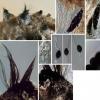
23-11-2025 11:16
Bohan JiaHi, I found small discs growing on dead stem of

21-11-2025 10:56
 Christopher Engelhardt
Christopher Engelhardt
Very small (~0,5 mm) white ascos, found yesterday

21-11-2025 11:52
Jean-Luc RangerBonjour à tous, on voit toujours 2 espèces areni

14-11-2025 16:26
 Marian Jagers
Marian Jagers
Hello everyone, On dead wood of Cytisus scoparius

17-11-2025 21:46
Philippe PELLICIERBonjour,Récolté sur bois pourrissant de feuillu
Another Podospora question
Chris Yeates,
19-07-2014 22:42
 This is yet another Podospora which has developed on a collection of rabbit dung (along with P. (Schizothecium) tetraspora, P. fimiseda and P. pleiospora).
This is yet another Podospora which has developed on a collection of rabbit dung (along with P. (Schizothecium) tetraspora, P. fimiseda and P. pleiospora).It seems to sit uncomfortably between P. setosa and P. curvicolla.
For the former are characters like the shape of the asci (clavate, not saccate), no asci with 256 spores and the gelatinous appendages which are persistent on the mature spores and do not disappear in water mounts.
But the spores seem small for P. setosa and would fit better in P. curvicolla - they measure 16.4-17.3 x 10.4-11.7µm; also in some cases the hairs could be considered 'agglutinated'. I know there are ASCOFrance members with lots of experience of these coprophiles, and would again be grateful for assistance.
Cordialement
Chris
Michel Delpont,
20-07-2014 10:02

Re : Another Podospora question
Hello Chris.
It is sometimes difficult to separate these two species, but the size of the spores and "agglutined" hairs closer to curvicolla.
It is important to measure a large number of spores to have a mean, especially since it is sometimes difficult to count the number of spores within the ascus. I also picked up some copies of P.curvicolla with little hairs "agglutined".
Michel.


